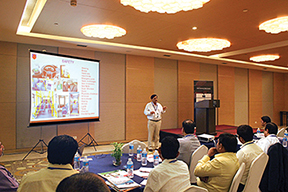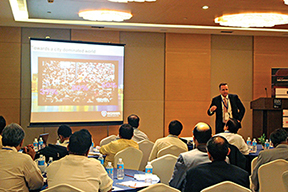


The reason for the truck body code’s delay, it seems, is the need to incorporate the learnings from the implementation of the bus code.
Story by:
Ashish Bhatia
It looks like the truck code is delayed. The reason for the delay, it seems, is the need to incorporate the learnings from the bus code. But then, Dattatray Saste, Consultant, Central Institute of Road Transport (CIRT), attributed the delay to the sheer scale of the truck transportation industry. He also cautioned against comparing the formulation of the truck code with that of the bus code at the recent Annual India Commercial Vehicle Summit held at Pune. Mentioned Saste that there were close to 17 lakh buses plying on Indian roads, which is a minuscule figure when compared to the number of trucks plying. Stressing upon the fact that passenger safety and comfort took precedence in the bus code, Saste informed, that in the truck code, it is the driver safety, co-driver safety and goods that should take precedence. He added, that the real reason for delay is also the magnanimity of scale. Perhaps the most important part of the exercise, the convertors (truck body builders), would expect to upgrade. The only way the Ministry of Roads, Transport and Highways (MoRTH) will be able to arrive at a consensus with them over the final draft of the code.
The truck body code, like the bus body code, requires Original Equipment Manufacturers (OEMs) and convertors to comply with a set of specifications for the truck’s cab, its load body, lighting, illumination, electrical equipment and wiring. There are a host of additional requirements that need to be complied with too, especially in case of vehicles that carry dangerous and hazardous goods specific to their constructional features. After the revised bus body code AIS-052 was notified in August 2015, those from the trucking industry pinned their hopes on a revised truck body code to follow sooner than later. The same may not happen; not for some time to come at least.
Expected to reorganise the truck body building sector whenever it is implemented, the truck code is certain to be a daunting task indeed. Especially when issues like design, safety and ergonomics are involved. Expressed Saste, “Can you guarantee that a lesser independent truck body builder can take care of the design element to contribute to driver ergonomics.” Crucial to the truck code, it looks like, is the need of have the driver cabin built separate from the load body. There would be a protective barrier designed between the two to prevent fatality in case of sudden braking. The load can otherwise crash into the driver’s cabin, Saste stated. The implementation of the trucking code is expected to validate the truck’s Gross Vehicle Weight (GVW), which impacts its load carrying capacity. The truck code is also expected to include compliance about vehicle stability, rear under-run and side under-run protection. Saste claimed that the truck code would be notified only after the bus code is fully adopted (in another six months) by all the stakeholders. He put a three year time line ahead of the truck code’s maturity in the market.
Transportation practices and challenges
In India, the number of multiple axle trucks is rising. A move to higher tonnage is visible. The tractor-trailer segment however has some way to go yet. This, despite standardisation in container freight, unlike in the West. Saste informed that there is a need for synchronisation between the axles and their load bearing capacity, size of the vehicle and the containers. Something that the convertors from the unorganised sector may not consider or understand. Especially when the intended use of the truck is taken into account. A design lacunae may lead to a load mismatch, further aggrevated by the casual approach of the operator. Operational success, it may be necessary for the operator to understand, would depend upon the type of goods; type of vehicle, and the vehicle design. It is imperative for vehicles to be able to carry diverse goods – from perishable goods, live stock to something as risky as nuclear and radioactive materials. What is missing is a clear guideline that advocates the transport of a particular type of good in a particular type of vehicle, and the need to store it in a particular way. The transportation industry may be warming up to new concepts like palletisation, the fact is, in the absence of a clear guideline, a good deal of ambiguity exists. Opined Saste, that warehousing in India is in complete contrast to that of the West. It is highly scattered. “The need is to clearly demarcate consumption markets and warehousing areas as distinct entities. An exhaustive warehousing policy is required to aid the truck code’s righteous implementation,” he added.
More codes
The Bus Code (AIS 052) has not addressed the growing sleeper coach market. Apart from the sleeper coach, school bus code, articulated bus code and a double decker bus code is said to be in the making. They are yet to be deliberated upon and notified. Stating that there is no standard for the sleeper coach the world over, Saste averred, “This would imply that the Indian version of the sleeper coach could find a basis in other parts of the world, albeit its successful implementation in India.” About the school bus code, Saste informed that it would be soon mandated. It is claimed to be engineered to support the safety provisions and comfort of school children. A code for ‘Tarmac’ commercial vehicles used for transporting passengers at airport terminals and ambulances is also said to be in the making.
Sustainability
Speaking at the CV Summit, Per Aleby, Director – Buses and Coaches, Scania Commercial Vehicles India Pvt Ltd., expressed the need to look at alternate fuels. He drew attention to the rising use of biofuels while explaining that the key to reduce reliance on oil lies there. Giving the example of Stockholm where half of the city buses run on biogas, Aleby said that it was possible to achieve Euro 6 standards right away with the use of biofuels. “India could thus leapfrog to a higher fuel standard if it wanted to,” he added. About the need for an additive to ignite the biofuel, ED95 that Scania uses in its ethanol-powered city bus at Nagpur, Aleby informed that it was being produced locally at Nagpur. The number of ethanol buses at Nagpur, he revealed, has risen to 50. Claiming that there was no issue in the supply, Aleby expressed that the need instead was to keep a check on the quality with a view of standardising the fuel across the country. The use of ethanol is at a nascent stage in India. The only known example of use are the ethanol buses at Nagpur as far as commercial vehicles are concerned. It did not come as a surprise therefore, when Aleby expressed that biogas could well outdo ethanol in the future. He did not forget to mention, that biogas and ethanol could coexist depending on the region the fuels are chosen from or for. Quality production of biofuels, it is clear, is a task that will have to be skillfully replicated if alternate fuel commercial vehicles were to proliferate. There is no doubt that the need is to reduce methane and CO2 emissions as much as it to plant more trees. Apart from the need to use alternate fuels increasingly, the success of the CV summit held at Pune was underlined by the discussion on the bus and truck code.





















